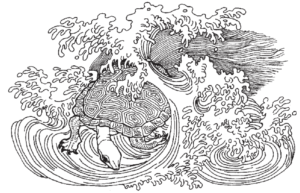Confucius and the U.S. Supreme Court
A figure of Confucius in flowing sleeves joins Moses, Hammurabi, and Solon among the lawgivers in the marble frieze encircling the Supreme Court’s hearing room in Washington, D.C.
Source: “Confucius and the Scholars,” The Atlantic Monthly, April 1999.
Official Chinese Definition of Good Government
Below is a sample question in an official test guide for the 1999 standard national examination for Chinese students seeking to enter master of arts programs.
Question: In evaluating a political system, the most important thing to look at is:
A. Whether the country is stable.
B. Whether or not it enhances the unity of the people and improves people’s lives.
C. Whether or not the forces of production can be developed.
D. Whether or not it has a tripartite separation of powers.
E. Whether people have the right to elect their leaders directly.
(A, B and C are correct. D and E are incorrect.)
Source: China Materials Press, 1999.
Japanese Generation Gap
“The homes of older people smell of fish and miso soup and the kids’ houses smell of America.” Ito Matome, a 64-year-old Tokyo resident, sums up the American influences in modern Japan.
Source: Far Eastern Economic Review, April 22, 1999.
Has the Subcontinent Always Benn Known for Poverty?
In ancient India, economic output grew faster than population, leading to a rise in per-capita income. This growth pattern emerged when the Buddhist Mauryas (321 B.C.E.–180 B.C.E.) first succeeded in establishing a Subcontinental empire. This led to a standard of living that was then unsurpassed and remained relatively unchanged for the subsequent millennia.
Source: Deepak Lal, “Golden Chains,” part of the Far Eastern Economic Review’s Asian Millennium Series, June 10, 1999.
American “Enlightenment” Toward Asia?
According to Claremont McKenna College professor Alfred Balitzer, “[Americans] used to show more interest in economic matters, but now they are receptive to Asian cultures and values.” Balitzer designed the May 1999 opinion poll, Survey of U.S.-Asia Relations, administered by Pacific Research and Strategies Inc. The sample included 1,500 registered voters nationwide and reflected the geographic and demographic makeup of the U.S. The margin of error was 3.5 percent.
Some Reported Poll Data:
85 percent of Americans sampled believed that America’s relations with Asia are as important as relations with Europe.
When asked whether the U.S. should impose its values on Asian countries to make desired economic, social, or political changes, 63 percent said no, 28 percent said yes, and the rest didn’t know.
71 percent of American respondents believed that Americans have something to learn from Asia despite the current economic crisis.
82 percent felt that Asian immigrants work hard, are family-oriented, and have contributed greatly to American society.
70 percent of American respondents believed that Americans could learn something useful from the philosophies of Confucius and Buddha.
Source: Japan Times, June 18, 1999.
Japanese Language in U.S. Elementary Schools
The Japan Foundation and Language Center in Los Angeles conducted a study of U.S. elementary school Japanese language programs during the 1998–1999 school year. Below are some of their findings:
141 elementary schools in 24 states offered Japanese in one form or another in 1998–99.
In 75 schools, one or more hours a week were devoted to Japanese with more focus on language.
In 46 schools Japanese instruction was less than one hour a week with more focus on familiarization of culture.
12 schools featured immersion programs with more than half of instruction in Japanese.
8 schools didn’t provide enough information for classification.
Source: The Breeze Quarterly, Spring 1999.
The Philippines and Coconuts
The Philippines is the world’s largest producer of coconuts (Indonesia is number two).
Coconut plantations account for a quarter of the country’s agricultural land.
Philippine coconut production skyrocketed in the nineteenth century because of European and American demand for coconut oil for various products, particularly margarine and soap.
Today, the poorest of the Philippines’ poor are small coconut farmers.
Source: Rigoberto Tiglao, “The Roots of Poverty,” part of the Far Eastern Economic Review’s Asian Millennium Series, June 10, 1999.


